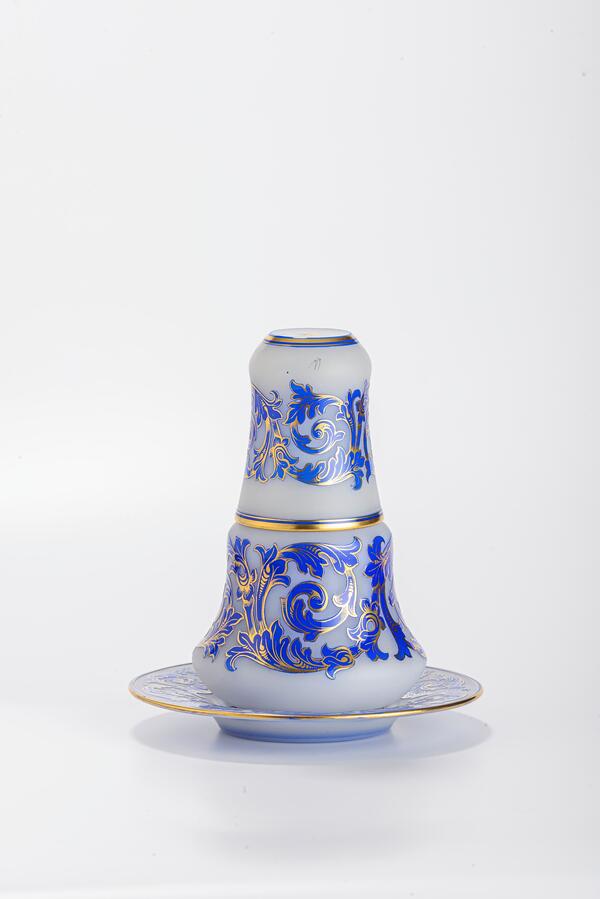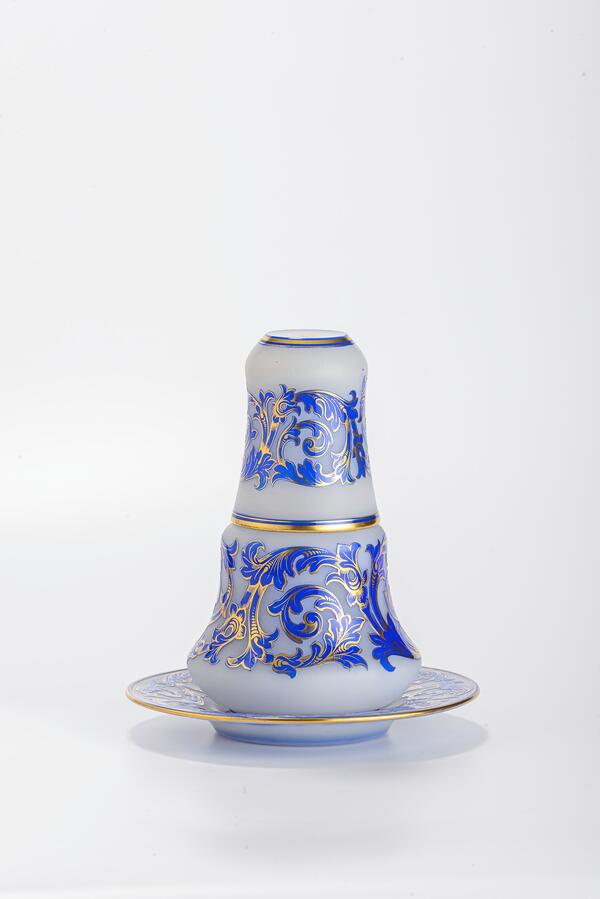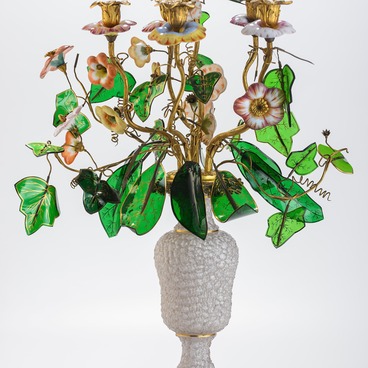The set presented in the exposition consists of a plate, a decanter and a glass. All three items are made of three layers of glass — colorless, milky and cobalt blue; the decanter and glass are bell-shaped. The blue-gold pattern of long carved acanthus leaves and thin stripes as well as the fully frosted milk glass create a feeling of something personal and intimate.
Such decanters were common in the 18th and especially in the 19th century. They were intended for one person and were not part of the services. As a rule, they were filled with water and placed in the bedrooms on bedside tables. A plate and a glass put on top (it also served as a stopper) were used in order not to splash water or damage the furniture. The design was chosen to correspond to the interior of the bedroom: it repeated the pattern and color scheme of the bedspreads and wallpaper, or, on the contrary, contrasted with them.
In the illustrated price list of 1898, such a product was simply “a decanter with a glass”; in the price list of 1911 it was called “a toilet decanter”. It was also called “a night decanter”, “a viardot decanter” (this name is mentioned in the museum’s inventory books) and “a selfish decanter” (this is how it is known today). Viardot decanters symbolized slow life. There were large and small decanters — the latter were made for children.
When these products were popular, they were made in Russia and abroad in various techniques: crackled or craquelé glass, glass threads, and overlaid two- or three-layer glass. There were also smooth decanters decorated with painting and gilding.
After the revolution, the demand for products of this kind gradually went to zero. For this reason, only a few samples made no later than the early 1940s have been preserved in the museum — one of them being the work of the famous factory master Mikhail Vertuzaev.
In the 1990s and the 2000s, the Red Giant factory decided to update the range of its products and tried to reintroduce this convenient and elegant household item. There was a small series production of viardot decanters, of which only one copy has been preserved in the collection.
Such decanters were common in the 18th and especially in the 19th century. They were intended for one person and were not part of the services. As a rule, they were filled with water and placed in the bedrooms on bedside tables. A plate and a glass put on top (it also served as a stopper) were used in order not to splash water or damage the furniture. The design was chosen to correspond to the interior of the bedroom: it repeated the pattern and color scheme of the bedspreads and wallpaper, or, on the contrary, contrasted with them.
In the illustrated price list of 1898, such a product was simply “a decanter with a glass”; in the price list of 1911 it was called “a toilet decanter”. It was also called “a night decanter”, “a viardot decanter” (this name is mentioned in the museum’s inventory books) and “a selfish decanter” (this is how it is known today). Viardot decanters symbolized slow life. There were large and small decanters — the latter were made for children.
When these products were popular, they were made in Russia and abroad in various techniques: crackled or craquelé glass, glass threads, and overlaid two- or three-layer glass. There were also smooth decanters decorated with painting and gilding.
After the revolution, the demand for products of this kind gradually went to zero. For this reason, only a few samples made no later than the early 1940s have been preserved in the museum — one of them being the work of the famous factory master Mikhail Vertuzaev.
In the 1990s and the 2000s, the Red Giant factory decided to update the range of its products and tried to reintroduce this convenient and elegant household item. There was a small series production of viardot decanters, of which only one copy has been preserved in the collection.





